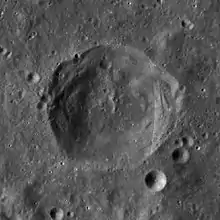Tacitus (crater)
Tacitus is a lunar impact crater located to the northwest of the crater Catharina, at the northern extension of the Rupes Altai ridge line. It was named after the 1st century Roman historian and writer Tacitus.[1] Directly west is the crater Almanon, and to the northeast is Cyrillus. To the southeast of Tacitus is a long chain of craters named the Catena Abulfeda. This chain runs to the northwest from the eastern edge of the Rupes Altai, continuing for over 200 kilometers.
 LRO WAC mosaic | |
| Coordinates | 16.2°S 19.0°E |
|---|---|
| Diameter | 40 km |
| Depth | 2.8 km |
| Colongitude | 340° at sunrise |
| Eponym | Cornelius Tacitus |

The crater terminates a ridge which forms part of the Rupes Altai. The outer wall has a small rampart, and the interior surfaces are terraced. The rim outline has a slight polygonal outline. There is a low ridge on the crater floor running from the north wall.
Satellite craters

By convention these features are identified on lunar maps by placing the letter on the side of the crater midpoint that is closest to Tacitus.
| Tacitus | Latitude | Longitude | Diameter |
|---|---|---|---|
| A | 17.4° S | 20.5° E | 11 km |
| B | 14.0° S | 20.4° E | 13 km |
| C | 13.6° S | 19.8° E | 9 km |
| D | 13.5° S | 21.0° E | 15 km |
| E | 13.9° S | 20.1° E | 9 km |
| F | 17.1° S | 17.6° E | 10 km |
| G | 17.4° S | 18.2° E | 6 km |
| H | 17.8° S | 18.5° E | 7 km |
| J | 14.9° S | 19.7° E | 3 km |
| K | 13.1° S | 20.1° E | 3 km |
| L | 14.4° S | 20.9° E | 6 km |
| M | 13.9° S | 21.5° E | 6 km |
| N | 16.9° S | 19.4° E | 7 km |
| O | 14.0° S | 21.9° E | 5 km |
| Q | 18.0° S | 20.5° E | 5 km |
| R | 16.7° S | 19.7° E | 5 km |
| S | 14.5° S | 19.1° E | 10 km |
| X | 15.8° S | 18.2° E | 4 km |
References
- "Tacitus (crater)". Gazetteer of Planetary Nomenclature. USGS Astrogeology Research Program.
- Andersson, L. E.; Whitaker, E. A. (1982). NASA Catalogue of Lunar Nomenclature. NASA RP-1097.CS1 maint: ref=harv (link)
- Bussey, B.; Spudis, P. (2004). The Clementine Atlas of the Moon. New York: Cambridge University Press. ISBN 978-0-521-81528-4.CS1 maint: ref=harv (link)
- Cocks, Elijah E.; Cocks, Josiah C. (1995). Who's Who on the Moon: A Biographical Dictionary of Lunar Nomenclature. Tudor Publishers. ISBN 978-0-936389-27-1.CS1 maint: ref=harv (link)
- McDowell, Jonathan (July 15, 2007). "Lunar Nomenclature". Jonathan's Space Report. Retrieved 2007-10-24.CS1 maint: ref=harv (link)
- Menzel, D. H.; Minnaert, M.; Levin, B.; Dollfus, A.; Bell, B. (1971). "Report on Lunar Nomenclature by the Working Group of Commission 17 of the IAU". Space Science Reviews. 12 (2): 136–186. Bibcode:1971SSRv...12..136M. doi:10.1007/BF00171763.CS1 maint: ref=harv (link)
- Moore, Patrick (2001). On the Moon. Sterling Publishing Co. ISBN 978-0-304-35469-6.CS1 maint: ref=harv (link)
- Price, Fred W. (1988). The Moon Observer's Handbook. Cambridge University Press. ISBN 978-0-521-33500-3.CS1 maint: ref=harv (link)
- Rükl, Antonín (1990). Atlas of the Moon. Kalmbach Books. ISBN 978-0-913135-17-4.CS1 maint: ref=harv (link)
- Webb, Rev. T. W. (1962). Celestial Objects for Common Telescopes (6th revised ed.). Dover. ISBN 978-0-486-20917-3.CS1 maint: ref=harv (link)
- Whitaker, Ewen A. (1999). Mapping and Naming the Moon. Cambridge University Press. ISBN 978-0-521-62248-6.CS1 maint: ref=harv (link)
- Wlasuk, Peter T. (2000). Observing the Moon. Springer. ISBN 978-1-85233-193-1.CS1 maint: ref=harv (link)